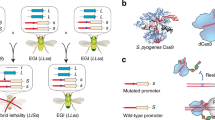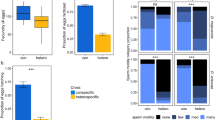Abstract
Post-mating mechanisms are central to the establishment of reproductive isolation between different, but closely related, species. Post-mating isolation mechanisms include hybrid breakdown, hybrid sterility and hybrid lethality1,2 and may, in some cases, be reinforced by pre-mating mechanisms such as ethological differentiation. In the Drosophila melanogaster species sub-group post-mating reproductive isolation is ensured by both the inviability and the sterility of hybrids3. For example when D. melanogaster females are crossed to D. simulans males the hybrid progeny are normally all female; the hybrid males die as third instar larvae4–6. The viable hybrid females are totally sterile4,5. Little is known of the genetic basis for either hybrid sterility or hybrid inviability, although Coyne and others7,8 have begun a genetic analysis of the sterility of hybrids within this species sub-group. We have discovered a single gene difference that rescues the otherwise inviable male hybrids from the cross between D. melanogaster females and males of its three closest relatives. The study of this locus may shed light on the genetic control of both speciation and development.
This is a preview of subscription content, access via your institution
Access options
Subscribe to this journal
Receive 51 print issues and online access
$199.00 per year
only $3.90 per issue
Buy this article
- Purchase on Springer Link
- Instant access to full article PDF
Prices may be subject to local taxes which are calculated during checkout
Similar content being viewed by others
References
1. Dobzhansky, T. Genetics of the Evolutionary Process (Columbia University Press, 1970). 2. Mayr, E. Animal Species and Evolution (Belknap, Cambridge, Massachusetts, 1963). 3. Bock, I. EvoL Biol 18, 41–70 (1984). 4. Sturtevant, A. H. Genetics 5, 488–500 (1920). 5. Sturtevant, A. H. Carnegie Inst. Wash. Pubs. 399, 1–62 (1929). 6. Hadorn, E. Rev. Suisse ZooL 68, 197–207 (1961). 7. Coyne, J. A. Proc. natn. Acad. Sci. U.S.A. 81, 4444–4447 (1984). 8. Coyne, J. A. & Charlesworth, B. Heredity 57, 243–246 (1986). 9. Lemeunier, F., David, J. R., Tsacas, L. & Ashburner, M. in The Genetics and Biology of Drosophila Vol. 3e (eds Ashburner, M., Carson, H. L. & Thompson, J. N.) 147–256 (Academic, London, 1986). 10. Lachaise, D., David, J. R., Lemeunier, F., Tsacas, L. & Ashburner, M. Evolution 40,262–271 (1986). 11. Watanabe, T. K. Jap. J. Genet. 54, 325–331 (1979). 12. Watanabe, T. K., Lee, W. H., Inoue, Y. & Kawanishi, M. Jap. J. Genet. 52, 1–8 (1977). 13. Lee, W. H. Jap. J. Genet. 53, 339–344 (1978). 14. David, J. R., Bocquet, C., Lemeunier, F. & Tsacas, L. /. Genet. 62, 93–100 (1976). 15. David, J. R., Lemeunier, F., Bocquet, C. & Tsacas, L. An. Genet 17, 235–241 (1974). 16. Morgan, T. H. Carnegie Inst. Wash. Pubs. 399, 201–222 (1929). 17. Livak, K. J. Genetics 107, 611–634 (1984).
Author information
Authors and Affiliations
Rights and permissions
About this article
Cite this article
Hutter, P., Ashburner, M. Genetic rescue of inviable hybrids between Drosophila melanogaster and its sibling species. Nature 327, 331–333 (1987). https://doi.org/10.1038/327331a0
Received:
Accepted:
Issue Date:
DOI: https://doi.org/10.1038/327331a0
This article is cited by
-
Hybrid larval lethality of Drosophila is caused by parent-of-origin expression: an insight from imaginal discs morphogenesis of Lhr pausing rescue hybrids of D. melanogaster and D. simulans
The Nucleus (2021)
-
Allelic asymmetry of the Lethal hybrid rescue (Lhr) gene expression in the hybrid between Drosophila melanogaster and D. simulans: confirmation by using genetic variations of D. melanogaster
Genetica (2014)
-
Functional conservation of the Drosophila hybrid incompatibility gene Lhr
BMC Evolutionary Biology (2011)
-
Drosophila simulans Lethal hybrid rescue mutation (Lhr) rescues inviable hybrids by restoring X chromosomal dosage compensation and causes fluctuating asymmetry of development
Journal of Genetics (2007)
-
Genes and speciation
Nature Reviews Genetics (2004)
Comments
By submitting a comment you agree to abide by our Terms and Community Guidelines. If you find something abusive or that does not comply with our terms or guidelines please flag it as inappropriate.



